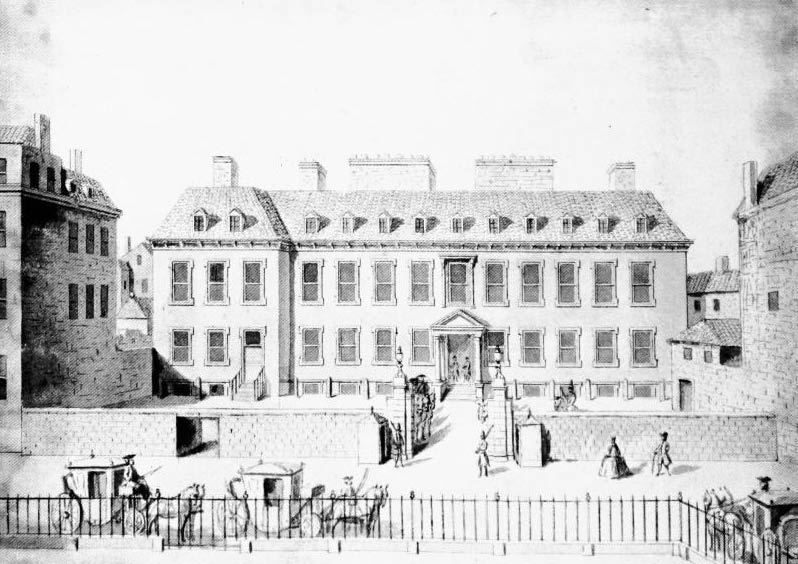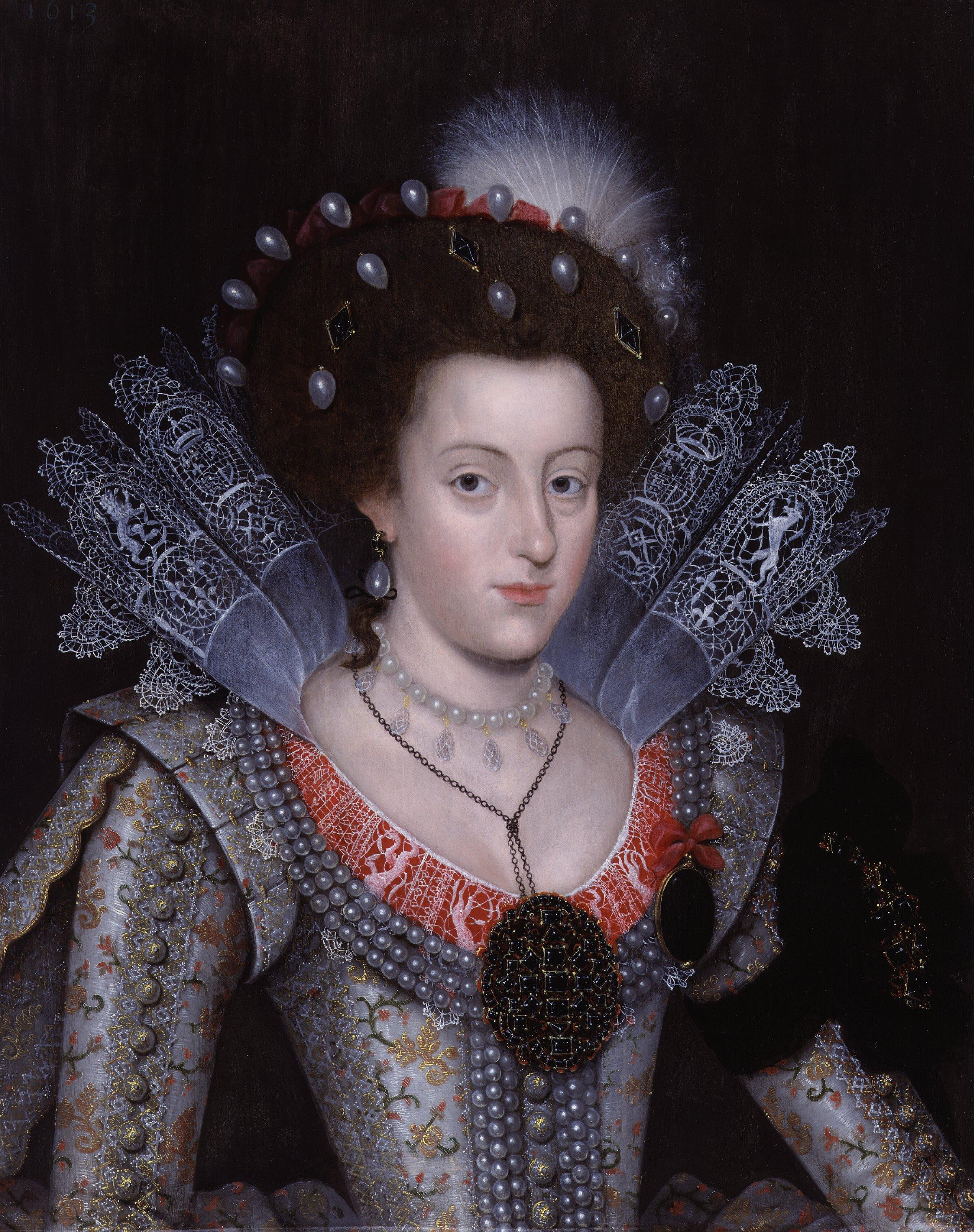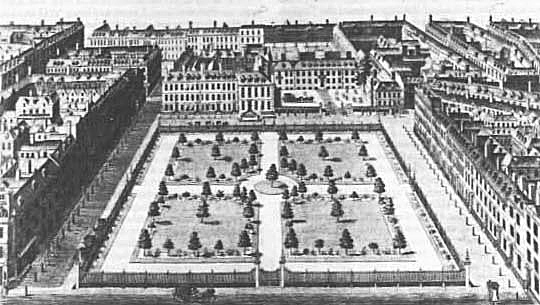Leicester House (Westminster) on:
[Wikipedia]
[Google]
[Amazon]
 Leicester House was a large aristocratic townhouse in
Leicester House was a large aristocratic townhouse in
 Leicester House was named for Robert Sidney, 2nd Earl of Leicester, who bought four acres of land in this part of Westminster, St Martin's Field, intending to build a new town house there. The area was not then built up, and the only nearby buildings were the armoury of the Military Company in Westminster to the north and the new town house of Sir William Howard, called Newport House, to the east.Sheppard (1966)
Leicester House was named for Robert Sidney, 2nd Earl of Leicester, who bought four acres of land in this part of Westminster, St Martin's Field, intending to build a new town house there. The area was not then built up, and the only nearby buildings were the armoury of the Military Company in Westminster to the north and the new town house of Sir William Howard, called Newport House, to the east.Sheppard (1966)
pp. 441–472
/ref> In August 1631, King Charles I ordered his Attorney General,
11 Secrets of Leicester Square
at londonist.com, accessed 14 May 2020 For a short time in 1662, Leicester House was occupied by Elizabeth Stuart, Queen of Bohemia, the eldest daughter of
For a short time in 1662, Leicester House was occupied by Elizabeth Stuart, Queen of Bohemia, the eldest daughter of 
 About November 1742,
About November 1742,  In 1774, Sir Ashton Lever took a lease on the house, converting the rooms on the first floor into a single large gallery running the length of the house, and in February 1775 opened a museum to display his Leverian collection. It had around 25,000 exhibits, said to be a small fraction of Lever's collections, and remained at Leicester House until 1788.
In 1774, Sir Ashton Lever took a lease on the house, converting the rooms on the first floor into a single large gallery running the length of the house, and in February 1775 opened a museum to display his Leverian collection. It had around 25,000 exhibits, said to be a small fraction of Lever's collections, and remained at Leicester House until 1788.Abstract of a Petition of Sir Ashton Lever
for a Bill to enable him to dispose of his museum] at bopcris.ac.uk, 29 September 2007
archived
/ref> Thanks to his mounting debts, George IV of the United Kingdom, George, Prince of Wales, the future George IV, sold the freehold of the house. After it was demolished in 1791, the house and its gardens were redeveloped as numbers 7–15, Leicester Square (on its north side), and some new houses on Leicester Place, Leicester Street, Lisle Street, and Sidney Street (now Sidney Place). After the redevelopment, the area lost prestige and became an entertainment and shopping district.
When the main house was pulled down, some of its stables became part of a new property on Lisle Street built between 1792 and 1795, later known as the White Bear Yard livery stables. These survived until demolished in 1906.
After the redevelopment, the area lost prestige and became an entertainment and shopping district.
When the main house was pulled down, some of its stables became part of a new property on Lisle Street built between 1792 and 1795, later known as the White Bear Yard livery stables. These survived until demolished in 1906.
 Leicester House was a large aristocratic townhouse in
Leicester House was a large aristocratic townhouse in Westminster
Westminster is an area of Central London, part of the wider City of Westminster.
The area, which extends from the River Thames to Oxford Street, has many visitor attractions and historic landmarks, including the Palace of Westminster, Bu ...
, London, to the north of where Leicester Square
Leicester Square ( ) is a pedestrianised square in the West End of London, England. It was laid out in 1670 as Leicester Fields, which was named after the recently built Leicester House, itself named after Robert Sidney, 2nd Earl of Leicester ...
now is. Built by the Earl of Leicester and completed in 1635, it was later occupied by Elizabeth Stuart, a former Queen of Bohemia
Bohemia ( ; cs, Čechy ; ; hsb, Čěska; szl, Czechy) is the westernmost and largest historical region of the Czech Republic. Bohemia can also refer to a wider area consisting of the historical Lands of the Bohemian Crown ruled by the Bohem ...
, and by the Hanoverian
The adjective Hanoverian is used to describe:
* British monarchs or supporters of the House of Hanover, the dynasty which ruled the United Kingdom from 1714 to 1901
* things relating to;
** Electorate of Hanover
** Kingdom of Hanover
** Province o ...
Princess of Wales.
From 1775 to 1788, the Leverian collection was on display in Leicester House. The house was sold and demolished in 1791.
History
 Leicester House was named for Robert Sidney, 2nd Earl of Leicester, who bought four acres of land in this part of Westminster, St Martin's Field, intending to build a new town house there. The area was not then built up, and the only nearby buildings were the armoury of the Military Company in Westminster to the north and the new town house of Sir William Howard, called Newport House, to the east.Sheppard (1966)
Leicester House was named for Robert Sidney, 2nd Earl of Leicester, who bought four acres of land in this part of Westminster, St Martin's Field, intending to build a new town house there. The area was not then built up, and the only nearby buildings were the armoury of the Military Company in Westminster to the north and the new town house of Sir William Howard, called Newport House, to the east.Sheppard (1966)pp. 441–472
/ref> In August 1631, King Charles I ordered his Attorney General,
Sir Robert Heath
Sir Robert Heath (20 May 1575 – 30 August 1649) was an English judge and politician who sat in the House of Commons from 1621 to 1625.
Early life
Heath was the son of Robert
Heath, attorney, and Anne Posyer. He was educated at Tunbridge ...
, to prepare a licence for Leicester to build a house "with necessary outhouses buildinges and gardens", but this stipulated that the outer walls must be wholly of brick or stone and added also "the forefronts to bee made in that uniforme sort and order as may best bewtifie the place".
The house was completed about 1635, according to Lord Leicester at a total cost of £8,000, . A map of 1658 by Richard Newcourt and William Faithorne
William Faithorne, often "the Elder" (161613 May 1691), was an English painter and engraver.
Life
Faithorne was born in London and was apprenticed to William Peake. On the outbreak of the Civil War Faithorne accompanied his master into the ...
shows it as an asymmetrical group of buildings around a courtyard, with a huge gatehouse taking up most of the southern range. This is very different from the house pictured in 1727 by Sutton Nicholls, and nothing is known which records a rebuilding. However, what is shown on the map of 1658 may simply be intended as a cartographic symbol for a great house. To build the house and its outbuildings, Lord Leicester had had to enclose some of his four acres, all of which was common land
Common land is land owned by a person or collectively by a number of persons, over which other persons have certain common rights, such as to allow their livestock to graze upon it, to collect Wood fuel, wood, or to cut turf for fuel.
A person ...
in the parish of St Martin in the Fields
St Martin-in-the-Fields is a Church of England parish church at the north-east corner of Trafalgar Square in the City of Westminster, London. It is dedicated to Saint Martin of Tours. There has been a church on the site since at least the mediev ...
. The commoners appealed to the king, and he appointed three members of the Privy Council
A privy council is a body that advises the head of state of a state, typically, but not always, in the context of a monarchic government. The word "privy" means "private" or "secret"; thus, a privy council was originally a committee of the mon ...
to arbitrate. They ordered that the part of the land still unenclosed be kept open, and this became known as Leicester Fields.
From April to August 1640, the new house was occupied by Thomas Wentworth, 1st Earl of Strafford, soon after his return from meetings in Dublin as Lord Deputy of Ireland
The Lord Deputy was the representative of the monarch and head of the Irish executive (government), executive under English rule, during the Lordship of Ireland and then the Kingdom of Ireland. He deputised prior to 1523 for the Viceroy of Ireland ...
. Development in and around London and Westminster continued during the 17th century, and the size and importance of Lord Leicester's house encouraged the building of other smart town houses nearby.Laura Reynolds11 Secrets of Leicester Square
at londonist.com, accessed 14 May 2020
 For a short time in 1662, Leicester House was occupied by Elizabeth Stuart, Queen of Bohemia, the eldest daughter of
For a short time in 1662, Leicester House was occupied by Elizabeth Stuart, Queen of Bohemia, the eldest daughter of James VI and I
James VI and I (James Charles Stuart; 19 June 1566 – 27 March 1625) was King of Scotland as James VI from 24 July 1567 and King of England and Ireland as James I from the union of the Scottish and English crowns on 24 March 1603 until ...
and the mother of Prince Rupert of the Rhine
Prince Rupert of the Rhine, Duke of Cumberland, (17 December 1619 (O.S.) / 27 December (N.S.) – 29 November 1682 (O.S.)) was an English army officer, admiral, scientist and colonial governor. He first came to prominence as a Royalist cavalr ...
and the Electress Sophia of Hanover; Elizabeth Stuart died in the house on 13 February 1662, Thomas Allen Thomas Allen may refer to:
Clergy
*Thomas Allen (nonconformist) (1608–1673), Anglican/nonconformist priest in England and New England
*Thomas Allen (dean of Chester) (died 1732)
*Thomas Allen (scholar) (1681–1755), Anglican priest in England
* ...
later noting that she "ended her unfortunate life" there. In 1672, Lady Sunderland, the wife of Robert Spencer, 2nd Earl of Sunderland, Lord Leicester's grandson, gave a dinner at the house attended by John Evelyn
John Evelyn (31 October 162027 February 1706) was an English writer, landowner, gardener, courtier and minor government official, who is now best known as a diarist. He was a founding Fellow of the Royal Society.
John Evelyn's diary, or memo ...
, who recalled that afterwards a fire-eater called Richardson entertained the company and "before us devour'd Brimston on glowing coales, chewing and swallowing them downe."
In 1674, Ralph, Lord Montagu, Master of the Great Wardrobe
The King's Wardrobe, together with the Chamber, made up the personal part of medieval English government known as the King's household. Originally the room where the king's clothes, armour, and treasure were stored, the term was expanded to descr ...
and later first Duke of Montagu
The title of Duke of Montagu has been created twice, firstly for the Montagu family of Boughton, Northamptonshire, and secondly for the Brudenell family, Earls of Cardigan. It was first created in the Peerage of England in 1705 for Ralph Mo ...
, took a lease on Leicester House, after marrying Lady Northumberland, the widow of Josceline Percy, 11th Earl of Northumberland
Josceline (or Joceline) Percy, 11th Earl of Northumberland, 5th Baron Percy (4 July 1644 – 31 May 1670), of Alnwick Castle, Northumberland and Petworth House, Sussex, was an English peer.
Origins
Percy was the eldest son of Algernon Percy, 1 ...
, a nephew of Lady Leicester. In 1676 Montagu was sent as English ambassador to Paris and ended his occupation. In 1677 the elderly Robert Sidney, 2nd Earl of Leicester died and was succeeded by his son Philip, 3rd Earl, who sold a large area of the garden for building Leicester Street, Lisle Street, and part of what is now Leicester Square. He also built a tavern in front of the courtyard and died in the house in 1698.

 About November 1742,
About November 1742, Frederick, Prince of Wales
Frederick, Prince of Wales, (Frederick Louis, ; 31 January 170731 March 1751), was the eldest son and heir apparent of King George II of Great Britain. He grew estranged from his parents, King George and Queen Caroline. Frederick was the fath ...
, the eldest son of George II George II or 2 may refer to:
People
* George II of Antioch (seventh century AD)
* George II of Armenia (late ninth century)
* George II of Abkhazia (916–960)
* Patriarch George II of Alexandria (1021–1051)
* George II of Georgia (1072–1089)
* ...
, moved into the house, after agreeing to lease it. In July 1743 Jocelyn Sidney, 7th Earl of Leicester, died without a successor, and the house was inherited by two sisters, Lady Sherard and Elizabeth Perry. On 16 August 1743, they granted a fourteen-year lease to the prince, running from Michaelmas
Michaelmas ( ; also known as the Feast of Saints Michael, Gabriel, and Raphael, the Feast of the Archangels, or the Feast of Saint Michael and All Angels) is a Christian festival observed in some Western liturgical calendars on 29 September, a ...
of 1742, and in 1744 Elizabeth Perry paid her sister £4,000 for her half-share. The successive Princes of Wales were natural alternative centres of political opposition, and the term "Leicester House faction" was used to describe the public men who were swayed by the Princes of Wales holding court there. On Frederick's death in 1751, the lease was inherited by his son the future George III
George III (George William Frederick; 4 June 173829 January 1820) was King of Great Britain and of Ireland from 25 October 1760 until the union of the two kingdoms on 1 January 1801, after which he was King of the United Kingdom of Great Br ...
, who was a minor, and for some twenty years his widow Augusta, Princess of Wales
Princess Augusta of Saxe-Gotha-Altenburg ( – 8 February 1772) was Princess of Wales by marriage to Frederick, Prince of Wales, eldest son and heir apparent of King George II. She never became queen consort, as Frederick predeceased his father ...
, continued the tradition of an alternative court at Leicester House.
for a Bill to enable him to dispose of his museum] at bopcris.ac.uk, 29 September 2007
archived
/ref> Thanks to his mounting debts, George IV of the United Kingdom, George, Prince of Wales, the future George IV, sold the freehold of the house. After it was demolished in 1791, the house and its gardens were redeveloped as numbers 7–15, Leicester Square (on its north side), and some new houses on Leicester Place, Leicester Street, Lisle Street, and Sidney Street (now Sidney Place).
 After the redevelopment, the area lost prestige and became an entertainment and shopping district.
When the main house was pulled down, some of its stables became part of a new property on Lisle Street built between 1792 and 1795, later known as the White Bear Yard livery stables. These survived until demolished in 1906.
After the redevelopment, the area lost prestige and became an entertainment and shopping district.
When the main house was pulled down, some of its stables became part of a new property on Lisle Street built between 1792 and 1795, later known as the White Bear Yard livery stables. These survived until demolished in 1906.
Notes
References
* * Cowie, Leonard W. "Leicester House," ''History Today'' (Jan 1973), Vol. 23 Issue 1, pp 30–37, online * {{Royal palaces in the United Kingdom 1635 establishments in England 1791 disestablishments in England Former houses in the City of Westminster Buildings and structures demolished in 1791 Houses completed in 1635 History of the City of Westminster Demolished buildings and structures in London Leicester Square Frederick, Prince of Wales